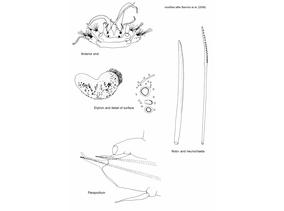You are here
Taxonomy
Harmothoe fuligineum (Baird, 1865)
Nomenclature
-
Subfamily: PolynoinaeGenus: Harmothoe
SUMMARY
Body with fewer than 50 segments. Prostomium with cephalic peaks; median antenna in anterior notch, style papillate, slightly inflated subdistally, then abruptly tapering; lateral antennae inserted ventrally, styles papillate, tapering; anterior pair of eyes dorsolateral on widest part of prostomium, posterior pair dorsal near hind margin of prostomium; palps papillate, tapering.
Tentaculophores lateral to prostomium, each with two notochaetae and a dorsal and ventral tentacular cirrus. Second segment with first pair of elytra, biramous parapodia, and long buccal cirri.
Fifteen pairs of elytra, covering dorsum, on segments 2, 4, 5, 7, then on every second segment to 23, 26, 29, 32; last segments cirrigerous; outer lateral margin and adjacent surface of elytra with dense fringe of long, filiform papillae, posterior margin without or with few, digitiform papillae; elytral surface covered with conical microtubercles, posterior half of elytra with numerous, globular to conical macrotubercles and some dark, pigmented patches. Cirrigerous segments with distinct dorsal tubercles; dorsal cirri with cylindrical cirrophore, style papillate, tapering. Ventral cirri with smooth, tapering style.
Parapodia biramous; notopodia with elongate acicular lobe; neuropodia with elongate prechaetal acicular lobe with digitiform supra-acicular process; neuropodial postchaetal lobe shorter than prechaetal lobe, rounded; tips of noto- and neuroacicula penetrating epidermis. Notochaetae stouter than neurochaetae; notochaetae with distinct rows of spines and blunt tip; neurochaetae falcate, with rows of spines distally; tip of neurochaetae bidentate with small secondary tooth (often abraded).
Size of large specimen, for example: length 29 mm, width 9 mm for 37 segments.
Synonyms
Hermadion fuligineum Baird, 1865
Harmothoe spinosa typica Willey, 1902




